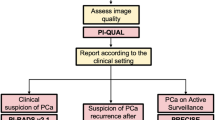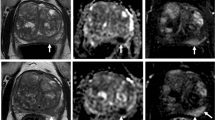Abstract
Background
Patients with favorable-risk prostate cancer on active surveillance (AS) are strictly followed for safer execution. Repeat protocol biopsy is essential for evaluating cancer aggressiveness. However, the acceptance rate of repeat biopsy is not high enough because of the burdens of biopsy. We assessed the impact of complications after the initial biopsy on repeat protocol biopsy at 1 year using data from the Prostate Cancer Research International: Active Surveillance (PRIAS)-JAPAN study.
Methods
We performed a retrospective analysis using a prospective cohort in the PRIAS-JAPAN study. Patients with favorable-risk prostate cancer (n = 856) who consented to participate in the PRIAS-JAPAN study from 2010 to 2018 were enrolled. Follow-up evaluations included regular prostate-specific antigen, digital rectal examination and biopsy. Rates of complications after biopsies and repeat protocol biopsy non-acceptance rate at 1 year were reported. Logistic regression analysis explored the association between the complications after the initial biopsy and repeat protocol biopsy non-acceptance.
Results
Altogether, 759 patients (88.7%) actually proceeded to protocol at 1 year. Repeat protocol biopsy non-acceptance rate at 1 year was 14.9%. Regarding complications after the initial biopsy, hematuria (p = 0.028) and pain (p < 0.001) rates were significantly higher in the repeat biopsy non-acceptance group, but infection (p = 0.056) and hematospermia (p = 0.337) rates were not different. On multivariate logistic regression analysis, pain was a significant predictor for repeat protocol biopsy non-acceptance (odds ratio 4.68, 95% confidence interval 1.864–11.75; p = 0.001).
Conclusions
Pain at the initial biopsy negatively impacts patients’ compliance with further protocol biopsies during AS.

Similar content being viewed by others
Change history
03 March 2022
A Correction to this paper has been published: https://doi.org/10.1007/s10147-022-02145-5
References
Choo R, Klotz L, Danjoux C et al (2002) Feasibility study: watchful waiting for localized low to intermediate grade prostate carcinoma with selective delayed intervention based on prostate specific antigen, histological and/or clinical progression. J Urol 167:1664–1669
Tosoian JJ, Mamawala M, Epstein JI et al (2015) Intermediate and longer-term outcomes from a prospective active-surveillance program for favorable-risk prostate cancer. J Clin Oncol 33:3379–3385
Klotz L, Vesprini D, Sethulavalan P et al (2015) Long-term following-up of a large active surveillance cohort of patients with prostate cancer. J Clin Oncol 33:272–277
Godtman RA, Holmberg E, Khatami A et al (2016) Long-term results of active surveillance in the Goteborg randomized, population-based prostate cancer screening trial. Eur Urol 70:760–766
National Comprehensive Cancer Network. Clinical practice guidelines in oncology prostate cancer version 1.2020
Mottet N, Bellmunt J, Bolla M et al (2017) EAU-ESTRO-SIOG guidelines on prostate cancer. Part 1: screening, diagnosis, and local treatment with curative intent. Eur Urol 71:618–629
Kakehi Y, Sugimoto M, Taoka R (2017) Evidenced-based clinical practice guideline for prostate cancer (summary: Japanese Urological Association, 2016 edition). Int J Urol 24:648–666
Bokhorst LP, Alberts AR, Rannikko A et al (2015) Compliance rates with the prostate cancer research international active surveillance (PRIAS) protocol and disease reclassification in noncompliers. Eur Urol 68:814–821
Bokhorst LP, Valdagni R, Rannikko A et al (2016) A decade of active surveillance in the PRIAS study: an update and evaluation of the criteria used to recommend a switch to active treatment. Eur Urol 70:954–960
Sugimoto M, Hirama H, Yamaguchi A et al (2015) Should inclusion criteria for active surveillance for low-risk prostate cancer be more stringent? From an interim analysis of PRIAS-JAPAN. World J Urol 33:981–987
van den Bergh RCN, Roemeling S, Roobol MJ et al (2007) Prospective validation of active surveillance in prostate cancer: the PRIAS study. Eur Urol 52:1560–1563
Loeb S, Vellekoop A, Ahmed HU et al (2013) Systematic review of complications of prostate biopsy. Eur Urol 64:876–892
Rosario DJ, Lane JA, Metcalfe C et al (2012) Short term outcomes of prostate biopsy in men tested for cancer by prostate specific antigen: prospective evaluation within ProtecT study. BMJ 344:d7894
Borghesi M, Ahmed H, Nam R et al (2017) Complications after systematic, random, and image-guided prostate biopsy. Eur Urol 71:353–365
Chiu PK, Alberts AR, Venderbos LDF et al (2017) Additional benefit of using a risk-based selection for prostate biopsy: an analysis of biopsy complications in the Rotterdam section of the European Randomized Study of Screening for Prostate Cancer. BJU I 120:394–400
Kakehi Y, Naito S, Japanese Urological Association (2008) Complication rates of ultrasound-guided prostate biopsy: a nation-wide survey in Japan. Int J Urol 15:319–321
Bokhorst LP, Lepistö I, Kakehi Y et al (2016) Complications after prostate biopsies in men on active surveillance and its effects on receiving further biopsies in the Prostate cancer Research International: active Surveillance (PRIAS) study. BJU Int 118:366–371
Loeb S, Cater HB, Berndt SI et al (2013) Is repeat prostate biopsy associated with a greater risk of hospitalization? Data from SEER-Medicare. J Urol 189:867–870
Halpern JA, Sedrakyan A, Dinerman B et al (2017) Indications, utilization and complications following prostate biopsy: New York state analysis. J Urol 197:1020–1025
Ehdaie B, Vertosick E, Spaliviero M et al (2014) The impact of repeat biopsies on infectious complications in men with prostate cancer on active surveillance. J Urol 191:660–664
Loeb S, Walter D, Curnyn C et al (2016) How active is active surveillance? Intensity of followup during active surveillance for prostate cancer in the United States. J Urol 196:721–726
Fischer S, Sun S, Howard LE et al (2016) Baseline subject characteristics predictive of compliance with study-mandated prostate biopsy in men at risk of prostate cancer: results from REDUCE. Prostate Cancer Prostatic Dis 19:202–208
Mäkinen T, Auvinen A, Hakama M et al (2002) Acceptability and complications of prostate biopsy in population-based PSA screening versus routine clinical practice: a prospective, controlled study. Urology 60:846–850
Glass AS, Dall’Era MA (2019) Use of multiparametric magnetic resonance imaging in prostate cancer active surveillance. BJU Int 124:730–737
Namekawa T, Fukasawa S, Komaru A et al (2015) Prospective evaluation of the safety of transrectal ultrasound-guided transperineal prostate biopsy based on adverse events. Int J Clin Oncol 20:1185–1191
Acknowledgements
The authors thank Dr Shintaro Narita, Dr Wataru Obara, Dr Mitsugu Kanehira, Dr Kazuo Nishimura, Dr Masashi Nakayama, Dr Norio Nonomura, Dr Motohide Uemura, Dr Kenichi Tabata, Dr Hideyasu Tsumura, Dr Hiroshi Okuno, Dr Takayoshi Miura, Dr Osamu Ogawa, Dr Shusuke Akamatsu, Dr Osamu Ukimura, Dr Takumi Shiroishi, Dr Hiroshi Fukuhara, Dr Tomomi Kamba, Dr Yoji Murakami, Dr Yasuo Yamamoto, Dr Tadashi Murata, Dr Akito Terai, Dr Hirohito Naito, Dr Kazuhiro Suzuki, Dr Yukio Kageyama, Dr Masaharu Inoue, Dr Kohei Hashimoto, Dr Naoya Masumori, Dr Yukio Naya, Dr Satoko Kojima, Dr Akira Miyajima, Dr Masahiro Nitta, Dr Koichiro Akakura, Dr Hiroyoshi Suzuki, Dr Naoto Kamiya, Dr Hiro-omi Kanayama, Dr Yoshito Kusuhara, Dr Kiyotaka Kawashima, Dr Hideki Sakai, Dr Tomoaki Hakariya, Dr Toshitaka Tanikawa, Dr Toshihiro Saito, Dr Yoshihiko Tomita, Dr Takashi Kasahara, Dr Takayuki Sugiyama, Dr Hideaki Miyake, Dr Jun Teishima, Dr Takeshi Ueno, Dr Takashige Abe, Dr Satoru Maruyama, Dr Toshiyuki Kamoto, Dr Naoki Terada, Dr Norihiko Tsuchiya, Dr Hidenori Kanno, Dr Hiroaki Matsumoto, Dr Seiichi Saito, Dr Hiromi Hirama, Dr Takashi Kimura, and Dr Isao Hara for their great contribution to this study.
Funding
This research received no specific grant from any funding agency in the public, commercial, or not-for-profit sectors.
Author information
Authors and Affiliations
Contributions
YT, TK, MS The conception or design of the work. YT, TK, RM, NS, KS, AY, MN, HK, KM, HS, SE, MM, KH, JI, ME, HB, TI, HK, TM, YK, MS: The acquisition of data for the work. YT: Analysis and interpretation of data for the work. YT: Drafting the work. TK, RM, NS, KS, AY, MN, HK, KM, HS, SE, MM, KH, JI, ME, HB, TI, HK, TM, YK, MS: Revising the work critically. TK, RM, NS, KS, AY, MN, HK, KM, HS, SE, MM, KH, JI, ME, HB, TI, HK, TM, YK, MS: Final approval of the version to be published.
Corresponding author
Ethics declarations
Conflict of interest
Dr Nobuo Shinohara received honoraria from Takeda Pharmaceutical Co. Ltd, Bayer Co. Ltd, Astellas Pharmaceutical Co. Ltd, Ono Pharmaceutical Co. Ltd, Pfizer Co Ltd, Novartis Pharmaceutical Co. Ltd, and AstraZeneca Co. Ltd, and received research funding from Ono Pharmaceutical Co. Ltd and Astellas Pharmaceutical Co. Ltd. Dr Masatoshi Eto received honoraria from Takeda Pharmaceutical Co. Ltd and Janssen Pharmaceutical Co. Ltd, and received research funding from Sanofi Co. Ltd, Bayer Co. Ltd, Astellas Pharmaceutical Co. Ltd and Takeda Pharmaceutical Co. Ltd. Dr Shin Egawa received scholarship donations from Takeda Pharmaceutical Co. Ltd, Kissei Pharmaceutical Co. Ltd, Ono Pharmaceutical Co. Ltd and Bayer Co. Ltd. Dr Akira Yokomizo received honoraria from Astellas Pharmaceutical Co. Ltd, Sanofi Co. Ltd and Bayer Co. Ltd. Dr Mikio Sugimoto received honoraria from Astellas Pharmaceutical Co. Ltd, Janssen Pharmaceutical Co. Ltd, Takeda Pharmaceutical Co. Ltd and AstraZeneca Co. Ltd, and received researching funding from Astellas Pharmaceutical Co. Ltd, Janssen Pharmaceutical Co. Ltd, AstraZeneca Co. Ltd, Bayer Co. Ltd, Ono Pharmaceutical Co. Ltd, Shin Nippon Biomedical Laboratories Ltd, Eisai Co. Ltd, and Merck Ltd, and received scholarship donations from Astellas Pharmaceutical Co. Ltd, Takeda Pharmaceutical Co. Ltd, Bayer Co. Ltd and Pfizer Co Ltd. Other authors declare that they have no conflict of interest.
Ethical approval
All procedures followed were in accordance with ethical standards of the responsible committee on human experimentation (institutional and national) and with the Helsinki Declaration of 1964 and its later amendments.
Additional information
Publisher's Note
Springer Nature remains neutral with regard to jurisdictional claims in published maps and institutional affiliations.
The original publication has been updated due to inclusion of missing entries in Table 4.
About this article
Cite this article
Tohi, Y., Kato, T., Matsumoto, R. et al. The impact of complications after initial prostate biopsy on repeat protocol biopsy acceptance rate. Results from the Prostate Cancer Research International: Active Surveillance JAPAN study. Int J Clin Oncol 25, 2107–2114 (2020). https://doi.org/10.1007/s10147-020-01761-3
Received:
Accepted:
Published:
Issue Date:
DOI: https://doi.org/10.1007/s10147-020-01761-3




